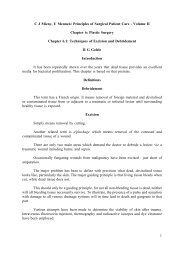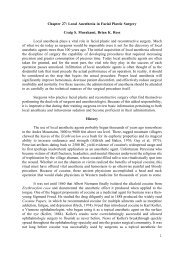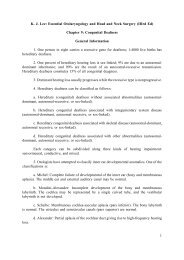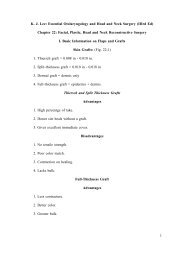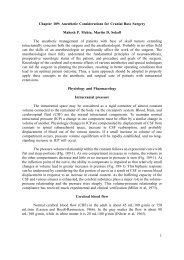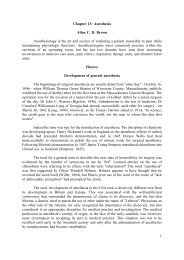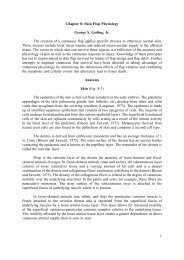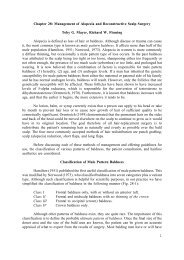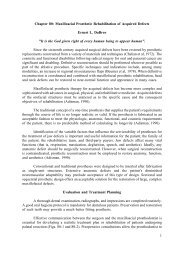1 Chapter 99: Congenital Disorders of the Larynx ... - Famona Site
1 Chapter 99: Congenital Disorders of the Larynx ... - Famona Site
1 Chapter 99: Congenital Disorders of the Larynx ... - Famona Site
Create successful ePaper yourself
Turn your PDF publications into a flip-book with our unique Google optimized e-Paper software.
A tracheotomy is almost always necessary in cases <strong>of</strong> bilateral vocal cord paralysis.<br />
When a neurologic abnormality exists, however, even though a tracheotomy may relieve <strong>the</strong><br />
airway obstruction, <strong>the</strong> abnormal respiratory function, apneic attacks, and cyanotic episodes<br />
may persist. Caudal displacement <strong>of</strong> <strong>the</strong> brainstem with <strong>the</strong> medulla and <strong>the</strong> cerebellum is<br />
thought to stretch <strong>the</strong> tenth cranial nerve (cranial nerve X). It may also cause disturbed<br />
function <strong>of</strong> <strong>the</strong> displaced respiratory center.<br />
Laryngoscopic examination. Confirmation <strong>of</strong> <strong>the</strong> clinical suspicion <strong>of</strong> unilateral or<br />
bilateral vocal cord paralysis must be made by direct laryngoscopic examination. Pressure<br />
from <strong>the</strong> laryngoscope blade or <strong>the</strong> direction <strong>of</strong> introduction must not distort assessment <strong>of</strong><br />
vocal cord function and <strong>the</strong> shape or general dynamics <strong>of</strong> <strong>the</strong> larynx. Such interference may<br />
cause a false diagnosis <strong>of</strong> lost vocal cord movement.<br />
The laryngoscope blade should be placed in <strong>the</strong> vallecula (in front <strong>of</strong> <strong>the</strong> epiglottis)<br />
at <strong>the</strong> end <strong>of</strong> <strong>the</strong> procedure, when anes<strong>the</strong>sia has been discontinued. As <strong>the</strong> patient recovers<br />
pharyngeal and laryngeal movement, time is ample for a complete, reliable evaluation during<br />
inspiration and vocalization. Vocal cord movement and <strong>the</strong> mobility <strong>of</strong> <strong>the</strong> cricoarytenoid joint<br />
are compared with that <strong>of</strong> <strong>the</strong> vocal cord on <strong>the</strong> o<strong>the</strong>r side to detect cricoarytenoid joint<br />
function. It is generally easy to make a confident diagnosis <strong>of</strong> unilateral vocal cord paralysis<br />
but not so easy to be certain <strong>of</strong> bilateral paralysis. For neonates in whom bilateral vocal cord<br />
paralysis is suspected but for whom a confident definitive diagnosis cannot be made at <strong>the</strong><br />
first examination, a nasotracheal tube can be left in situ and reexamination performed some<br />
days or a week later. If bilateral vocal cord paralysis is confirmed, <strong>the</strong>n a tracheotomy is<br />
performed. A tracheotomy is virtually always necessary for bilateral vocal cord paralysis and<br />
sometimes necessary even in cases <strong>of</strong> unilateral vocal cord paralysis with stridor and partial<br />
airway obstruction or troublesome aspiration.<br />
Vocal cord paralysis can usually be reliably assessed with a flexible fiberoptic<br />
laryngoscope, ei<strong>the</strong>r in <strong>the</strong> unanes<strong>the</strong>tized child or during spontaneous respiration anes<strong>the</strong>sia.<br />
Management<br />
Spontaneous resolution <strong>of</strong> <strong>the</strong> paralysis sometimes occur. In unilateral cases this results<br />
in improvement <strong>of</strong> <strong>the</strong> cry. In bilateral cases <strong>the</strong> airway improvement is usually sufficient for<br />
removal <strong>of</strong> <strong>the</strong> tracheotomy tube.<br />
Correction <strong>of</strong> <strong>the</strong> airway obstruction in unremitting bilateral paralysis is a major<br />
problem, and <strong>the</strong> optimal age for fur<strong>the</strong>r surgical procedures is conjectural.<br />
No reports have been made <strong>of</strong> <strong>the</strong> results <strong>of</strong> nerve-muscle pedicle reinnervation in <strong>the</strong><br />
pediatric age group. Reasonably, however, this operation can be considered for patients over<br />
<strong>the</strong> age <strong>of</strong> 4 years. The surgery is performed exclusively in <strong>the</strong> s<strong>of</strong>t tissues <strong>of</strong> <strong>the</strong> neck; <strong>the</strong><br />
integrity <strong>of</strong> <strong>the</strong> larynx is not breached; and should <strong>the</strong> operation be unsuccessful, an<br />
arytenoidectomy can be performed later at a suitable age. The results <strong>of</strong> an arytenoidectomy<br />
(Cohen, 1973) are more predictable in maintaining a good voice and obtaining a good airway<br />
so that decannulation is possible. Some <strong>of</strong> <strong>the</strong> patients continue to have stridulous breathing<br />
at night and do not obtain normal exercise tolerance.<br />
21




